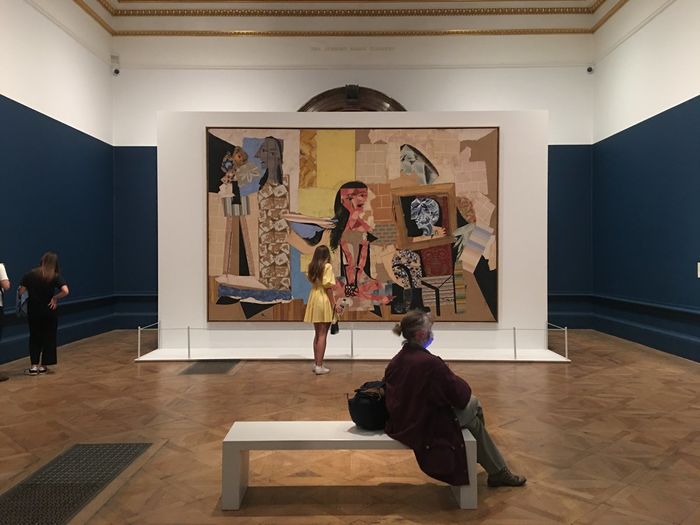Gertrude Stein and the defamiliarisation of the familiar
Phil Tarrant muses on the work of Gertrude Stein, understood as the literary counterpart to cubism, in the context of being confined to the familiar during a national lockdown.
We find ourselves amid a third national lockdown, confined to our homes, to a certain pattern of being. We have done this before; though the times are said to be unprecedented, this word means very little to me, repeated to the point of the deadened signifier. For many of us, the experience of lockdown is characterised by repetition: the mundane, the banal, the familiar, the homogenising of the temporal
And so what can be done to cut through the familiar? Reading, perhaps, is a good way of breaking up the monotony of lockdown life. Many websites have created lists of ‘escapist’ literature to pass the time. The problem with escapism, though, lies in its ephemerality: it always entails an eventual return to reality.
Literature need not be a break from one’s immediate surroundings; it can also be a way of reorienting oneself within them. Enter Gertrude Stein, one of the most prolific writers of the early twentieth century. Stein moved from America to Paris in 1903, involving herself in the now legendary cultural milieu of the Left Bank. She was a leading patron of modern art, possessing collected works by the likes of Matisse and Picasso, the latter of whom was a close friend of Stein and even painted her portrait. Her salon became an intellectual and artistic hub, drawing in American expatriate writers such as Hemingway and Fitzgerald. To this day, Stein is remembered largely for who she knew and the cultural scene she was a part of. As such, she is often overlooked as a leading modernist writer in her own right, with much of her writing simply (and wrongly) dismissed as obscure.
"Stein herself was greatly influenced by Cubist painting, and was very much preoccupied with the act of seeing."
Her work is vital. The scene of her collection of prose poetry Tender Buttons is the confines of insular, domestic space, where we find ourselves at the present moment. The book is divided into three sections entitled "Objects," "Food," and "Rooms"; the titles of individual poems denote everyday objects, such as "A Blue Coat," "A Piano," and "A Chair". The relationship of the poems to their subjects is non-realist, however. The text opens with the poem "A CARAFE, THAT IS A BLIND GLASS":
"A kind in glass and a cousin, a spectacle and nothing strange a single hurt color and an arrangement in a system to pointing. All this and not ordinary, not unordered in not resembling. The difference is spreading."
The poem is preoccupied with spatial relations, movement, and surroundings. The glass' relationship with the environment is characterised by instability and fragmentation. Take the poem’s last line: "the difference is spreading," or the first line of "Rooms": "act so that there is no use in a center." This trope of decentralisation abounds in the work as a whole. Referentiality is simultaneously constructed and deconstructed within the text; the referent of the carafe in the above poem does not give the poem a central meaning, and yet any attempt at finding meaning is put in relation to the referent.
So meaning, the relation of the signifier to the signified, is unstable, fluctuating, perpetually on the point of disintegration. In this way Stein’s work can be seen as the literary counterpart to Cubism. Cubist painting was central to the deconstruction of one-point perspective, a dominant convention in post-Renaissance visual arts based on the impression that objects get smaller the further away you are from them. This idea of perspective bears little relation to how we actually see, however. It is an ideal view, implying a motionless observer detached from the object depicted (think of all those still-life paintings of fruit).
This idea of perspective is illusory; it is a way of abstracting experience, restructuring it, and making it stable. In real life, the observer and what is observed are part of the same field; we interact with our environment, and as we move within it, so do the objects of our vision – each movement is a shift in perspective. Our visual experience is fragmentary, unstable, mosaic-like, never still. Stein herself was greatly influenced by Cubist painting, and was very much preoccupied with the act of seeing. As such the decentralisation of meaning in her work – its constant construction and deconstruction in relation to the signifier and what is signified – reflects the fluctuating and active relationship we have with our visual environment.
"We interact with our environment, and as we move within it, so do the objects of our vision – each movement is a shift in perspective"
Stein is defamiliarising the familiar, making it strange. She highlights the impenetrability of even our immediate surroundings: the constant, inexhaustible movement of the eye, the shifting perspective, the ever-fluctuating relation between objects, the meaning between subject and object. The confines of our environment, limited as they may be now, are never mundane.
 News / Eight Cambridge researchers awarded €17m in ERC research grants27 December 2025
News / Eight Cambridge researchers awarded €17m in ERC research grants27 December 2025 News / Clare Hall spent over £500k opposing busway 24 December 2025
News / Clare Hall spent over £500k opposing busway 24 December 2025 Comment / League tables do more harm than good26 December 2025
Comment / League tables do more harm than good26 December 2025 Comment / The ‘class’ of Cambridge24 December 2025
Comment / The ‘class’ of Cambridge24 December 2025 News / Caius mourns its tree-mendous loss23 December 2025
News / Caius mourns its tree-mendous loss23 December 2025









